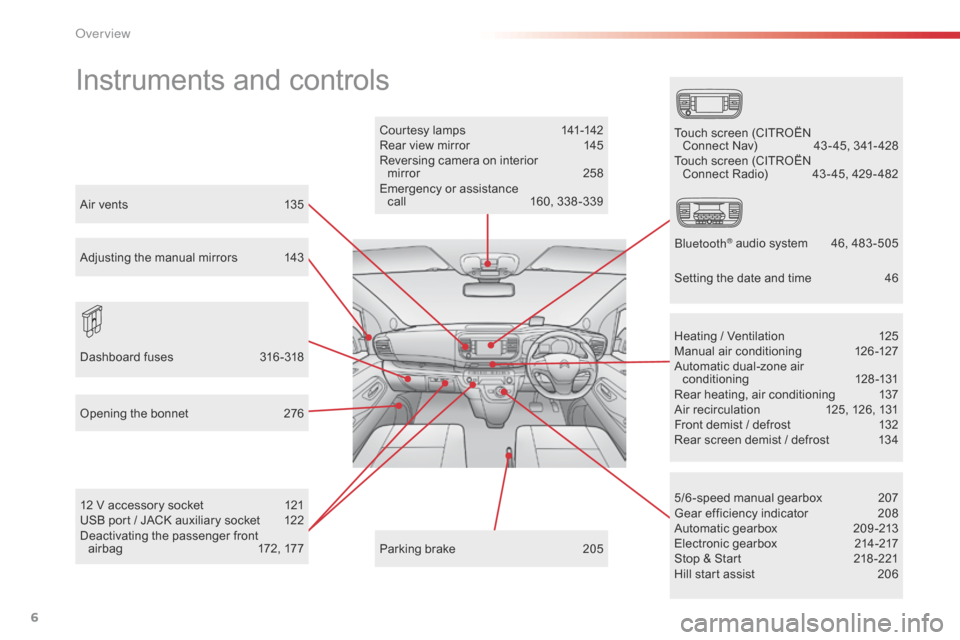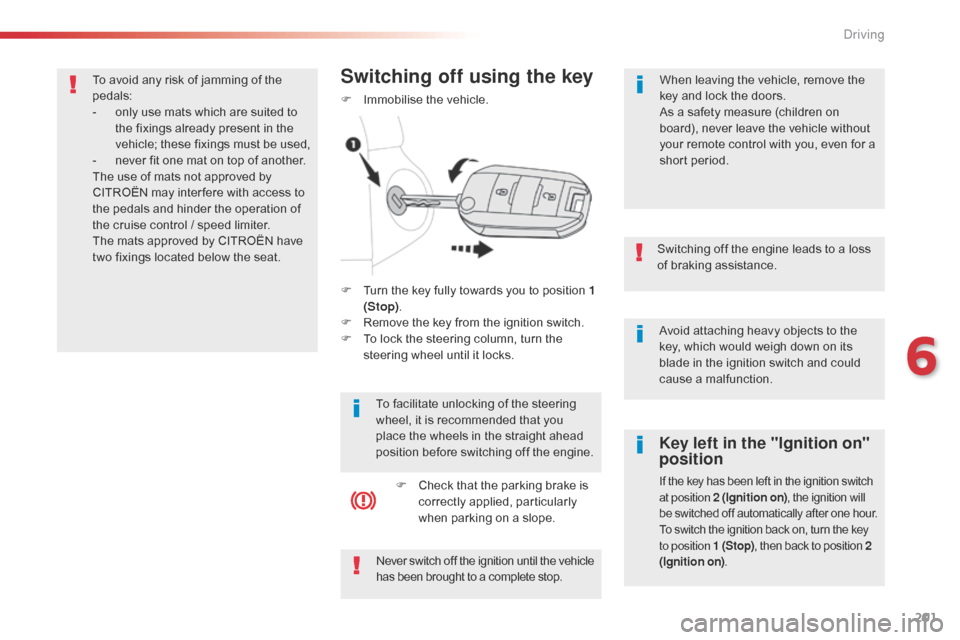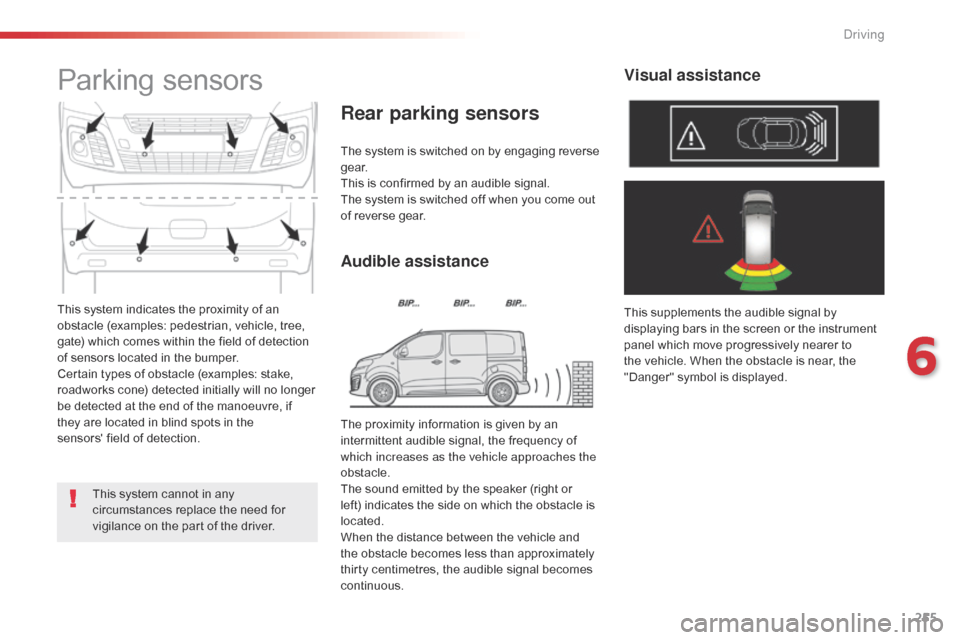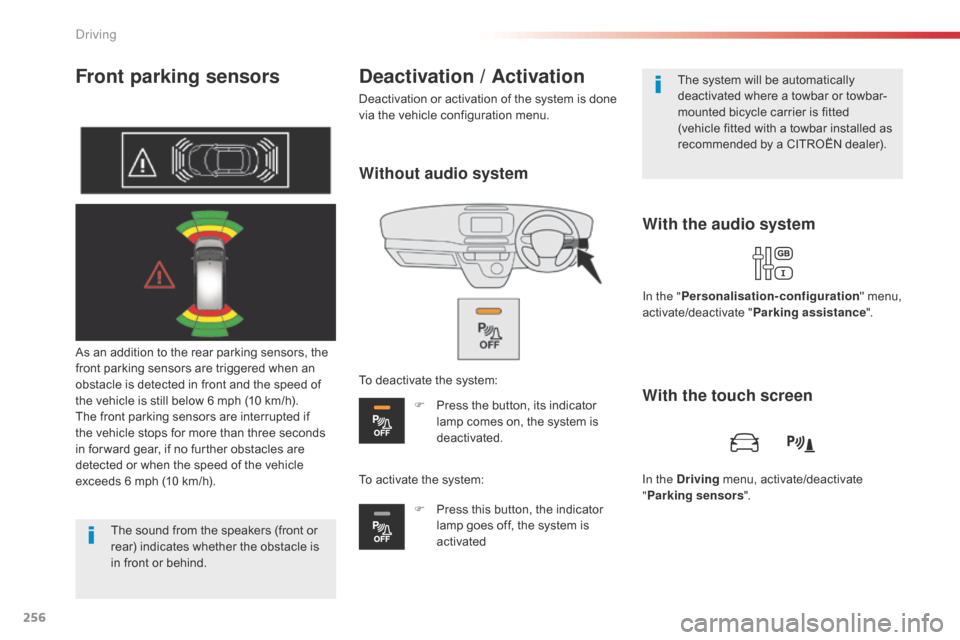park assist Citroen JUMPY RHD 2016 2.G Owner's Manual
[x] Cancel search | Manufacturer: CITROEN, Model Year: 2016, Model line: JUMPY RHD, Model: Citroen JUMPY RHD 2016 2.GPages: 520, PDF Size: 10.54 MB
Page 5 of 520

.
.
Driving recommendations 196
Starting-switching off the engine, manual key, remote control
1
99
Starting-switching off the engine, "Keyless Entry and Starting"
2
02
Parking brake
2
05
Hill start assist
2
06
5 -speed manual gearbox
2
07
6 -speed manual gearbox
2
07
Gear ef ficiency indicator
2
08
Automatic gearbox
2
09
Electronic gearbox
2
14
Stop & Start
2
18
Head-up display
2
22
Memorising speeds
2
24
Speed limit recognition
2
25
Speed limiter
2
29
Cruise control
2
32
Dynamic cruise control
2
36
Collision Risk Alert and Active Safety Brake
2
43
Lane departure warning system
2
48
Fatigue detection system
2
50
Blind spot monitoring system
2
52
Parking sensors
2
55
Reversing camera, interior mirror
2
58
180° rear vision
2
59
Under-inflation detection
2
62Fuel tank
2 65
Diesel misfuel prevention
2 66
Snow chains
2
68
Towing a trailer
2
69
Energy economy mode
2
70
Accessories
2
71
Roof bars / Roof rack
2
73
Changing a wiper blade
2
74
Bonnet
2
76
Diesel engine
2
77
Checking levels
2
78
Checks
2
81
AdBlue
® and SCR system
(BlueHDi Diesel) 2 83
Warning triangle (stowing)
2
87
Tool box
2
87
Temporary puncture repair kit
2
90
Changing a wheel
2
96
Changing a bulb
3
03
Changing a fuse
3
16
12 V battery
3
21
Towing
325
R
unning out of fuel (Diesel)
3
27Dimensions
3
28
Engines
3
32
Weights
3
32
Identification markings
3
37
Driving
Practical information
In the event of a breakdown Technical data
Emergency or assistance 3
38
CITROËN Connect Nav 3 41
CITROËN Connect Radio
4
29
Bluetooth
® audio system 4 83
Audio and telematics
Alphabetical index
Contents
Page 8 of 520

6
Instruments and controls
Courtesy lamps 141-142
Rear view mirror 1 45
Reversing camera on interior mirror
2
58
Emergency or assistance call
1
60, 338 -339
12 V accessory socket
1
21
USB port / JACK auxiliary socket
1
22
Deactivating the passenger front airbag
1
72, 177 5/6 -speed manual gearbox
2
07
Gear efficiency indicator
2
08
Automatic gearbox
2
09 -213
Electronic gearbox
2
14-217
Stop & Start
2
18 -221
Hill start assist
2
06
Heating / Ventilation
1
25
Manual air conditioning
1
26-127
Automatic dual-zone air conditioning
1
28-131
Rear heating, air conditioning
1
37
Air recirculation
1
25, 126, 131
Front demist / defrost
1
32
Rear screen demist / defrost
1
34
Parking brake
2
05
Opening the bonnet
2
76
Dashboard fuses
3
16 -318 Touch screen (CITROËN
Connect Nav)
4 3 - 45, 341- 428
Touch screen (CITROËN Connect Radio)
4
3 - 45, 429 - 482
Bluetooth
® audio system 4 6, 483 -505
Air vents
1
35
Adjusting the manual mirrors
1
43
Setting the date and time
4
6
Over view
Page 203 of 520

201
Avoid attaching heavy objects to the
key, which would weigh down on its
blade in the ignition switch and could
cause a malfunction.
Switching off the engine leads to a loss
of braking assistance.
Key left in the "Ignition on"
position
If the key has been left in the ignition switch
at position 2 (Ignition on)
, the ignition will
be switched off automatically after one hour.
To switch the ignition back on, turn the key
to position 1 (Stop) , then back to position 2
(Ignition on) .
Never switch off the ignition until the vehicle
has been brought to a complete stop.
F Turn the key fully towards you to position 1
(Stop) .
F
R
emove the key from the ignition switch.
F
T
o lock the steering column, turn the
steering wheel until it locks.
Switching off using the key
F Immobilise the vehicle.
To facilitate unlocking of the steering
wheel, it is recommended that you
place the wheels in the straight ahead
position before switching off the engine.F
C
heck that the parking brake is
correctly applied, particularly
when parking on a slope. When leaving the vehicle, remove the
key and lock the doors.
As a safety measure (children on
board), never leave the vehicle without
your remote control with you, even for a
short period.
To avoid any risk of jamming of the
pedals:
-
o
nly use mats which are suited to
the fixings already present in the
vehicle; these fixings must be used,
-
n
ever fit one mat on top of another.
The use of mats not approved by
CITROËN may inter fere with access to
the pedals and hinder the operation of
the cruise control / speed limiter.
The mats approved by CITROËN have
two fixings located below the seat.
6
Driving
Page 208 of 520

206
Hill start assist
System which keeps your vehicle immobilised
temporarily (approximately 2 seconds) when
starting on a gradient, the time it takes to
move your foot from the brake pedal to the
accelerator pedal.
It only operates when:
-
t
he vehicle is completely stationary, with
your foot on the brake pedal,
-
t
he driver’s door is closed.
This hill start assist system cannot be
deactivated.
On a descending slope, with the vehicle
stationary and reverse gear engaged, the
vehicle is held momentarily when you
release the brake pedal.
On an ascending slope, with the vehicle
stationary, the vehicle is held for a momentarily
when you release the brake pedal.
Operating fault
F If your vehicle has a manual gearbox, place
the lever in the first gear position or in
neutral.
F
I
f your vehicle has an automatic gearbox,
place the selector at position D or select
manual operation M.
F
I
f your vehicle has an electronic gearbox,
place the selector at position A or M .If a fault in the system occurs, this warning
lamp comes on accompanied by a message.
Contact a CITROËN dealer or a qualified
workshop as soon as possible to have the
system checked.
Do not leave the vehicle while it is being
held in the hill start assist phase.
If you need to get out of the vehicle with
the engine running, apply the parking
brake manually then ensure that the
parking brake indicator lamp is on.
If your vehicle has an automatic
gearbox and you have to move off on
a steep slope (rising or falling) with a
loaded vehicle, press the brake pedal ,
select position D , release the parking
brake then release the brake pedal.
Driving
Page 221 of 520

219
Going into engine
START mode
START mode is invoked automatically in
certain temporary conditions (examples:
battery charge, engine temperature, braking
assistance, air conditioning setting) to assure
correct operation of the system and mainly
when:
-
y
ou open the driver's door,
-
y
ou open a sliding side door,
-
y
ou unfasten the driver's seat belt,
-
t
he speed of the vehicle exceeds 15 mph
(25 km/h) or 2 mph (3 km/h) (depending on
the engine) with a manual gearbox,
-
t
he speed of the vehicle exceeds 2 mph
(3
km/h) with an automatic gearbox,
Special cases: START invoked
automatically
In this case the "ECO" warning
lamp flashes for a few seconds, then
goes
off.
This operation is perfectly normal.
If your vehicle has a manual gearbox
, the
" ECO " indicator lamp goes off in the instrument
panel and the engine restarts automatically
when you fully depress the clutch pedal.
If your vehicle has an automatic gearbox , the
" ECO " lamp goes off in the instrument panel
and the engine restarts automatically when:
-
y
ou release the brake pedal with the gear
selector in position D or M ,
-
y
ou are in position N with the brake pedal
released and you move the gear selector to
position D or M ,
-
y
ou engage reverse.
If your vehicle has an electronic gearbox , the
" ECO " lamp goes off in the instrument panel
and the engine restarts automatically when:
-
y
ou release the brake pedal with the gear
selector in position A or M ,
-
y
ou are in position N with the brake pedal
released and you move the gear selector to
position A or M ,
-
y
ou enegage reverse.
Special cases: STOP mode not
available
STOP mode is not invoked in certain temporary
conditions (examples: battery charge, engine
temperature, braking assistance, ambient
temperature) to assure correct operation of the
system and mainly when:
-
t
he vehicle is on a steep slope (rising or
falling),
-
t
he driver's door is open,
-
a s
liding side door is open,
-
t
he driver's seat belt is not fastened,
-
t
he vehicle has not exceeded 6 mph
(10
km/h) since the last engine start by the
driver,
-
t
he electric parking brake is applied or
being applied,
-
t
he engine is needed to maintain a
comfortable temperature in the passenger
compartment,
-
d
emisting is active.In this case, the "ECO" warning
lamp flashes for a few seconds then
goes
off.
This operation is perfectly normal.
6
Driving
Page 257 of 520

255
This system indicates the proximity of an
obstacle (examples: pedestrian, vehicle, tree,
gate) which comes within the field of detection
of sensors located in the bumper.
Certain types of obstacle (examples: stake,
roadworks cone) detected initially will no longer
be detected at the end of the manoeuvre, if
they are located in blind spots in the
sensors' field of detection.
Parking sensors
The system is switched on by engaging reverse
g e a r.
This is confirmed by an audible signal.
The system is switched off when you come out
of reverse gear.
Audible assistance
Rear parking sensors
This supplements the audible signal by
displaying bars in the screen or the instrument
panel which move progressively nearer to
the vehicle. When the obstacle is near, the
"Danger" symbol is displayed.
Visual assistance
This system cannot in any
circumstances replace the need for
vigilance on the part of the driver.The proximity information is given by an
intermittent audible signal, the frequency of
which increases as the vehicle approaches the
obstacle.
The sound emitted by the speaker (right or
left) indicates the side on which the obstacle is
located.
When the distance between the vehicle and
the obstacle becomes less than approximately
thirty centimetres, the audible signal becomes
continuous.
6
Driving
Page 258 of 520

256
Front parking sensors
As an addition to the rear parking sensors, the
front parking sensors are triggered when an
obstacle is detected in front and the speed of
the vehicle is still below 6 mph (10 km/h).
The front parking sensors are interrupted if
the vehicle stops for more than three seconds
in for ward gear, if no further obstacles are
detected or when the speed of the vehicle
exceeds 6 mph (10 km/h).
With the audio system
Deactivation / Activation
Deactivation or activation of the system is done
via the vehicle configuration menu.
The sound from the speakers (front or
rear) indicates whether the obstacle is
in front or behind. The system will be automatically
deactivated where a towbar or towbar-
mounted bicycle carrier is fitted
(vehicle fitted with a towbar installed as
recommended by a CITROËN dealer).
In the " Personalisation-configuration " menu,
activate/deactivate " Parking assistance ".
With the touch screen
In the Driving menu, activate/deactivate
" Parking sensors ".
Without audio system
To deactivate the system:
F
P
ress the button, its indicator
lamp comes on, the system is
deactivated.
To activate the system: F
P
ress this button, the indicator
lamp goes off, the system is
activated
Driving
Page 320 of 520

318
FuseN° Rating
(A) Functions
F1 10Electric power steering, clutch switch.
F4 15Horn.
F5 20Front/rear screenwash pump.
F6 20Front/rear screenwash pump.
F7 10Rear 12 V accessory socket.
F8 20Single or double rear wipers.
F10/F11 30Front /rear exterior and interior locks.
F13 10Front air conditioning controls, audio system controls,
gear lever, head-up display.
F14 5Alarm, emergency and assistance calls.
F17 5Instrument panel.
F19 3Steering mounted controls.
F21 3"Keyless Entry and Starting" system or ignition switch.
F22 3Rain and sunshine sensor, multifunction detection camera.
F23 5Seat belt unfastened or not fastened display screen.
F24 5Touch screen, reversing camera and parking sensors.
F25 5Airbags.
F29 20Audio system, touch screen, CD player, navigation.
F31 15Audio system (battery +).
F32 15Front 12 V accessory socket.
F34 5Blind spot monitoring system, door mirror electric controls.
F35 5Heated washer jets, headlamp beam height control.
F36 5Torch charger, rear courtesy lamp.Version 1 (Eco)
The fuses described hereafter vary according
to the equipment in your vehicle.
In the event of a breakdown
Page 321 of 520

319
FuseN° Rating
(A) Functions
F1 3"Keyless Entry and Starting" system or ignition switch.
F5 5Touch screen, reversing camera and parking sensors.
F7 10Rear air conditioning controls, Hi-Fi amplifier.
F8 20Single or double rear wiper.
F10/F11 30Front /rear exterior and interior locks.
F12 3Alarm.
F17 10Rear 12 V accessory socket.
F18 5Emergency and assistance calls.
F21 3Torch charger, rear courtesy lamp.
F22 3Glove box lamp, rear courtesy lamps.
F23 5Blind spot monitoring system, door mirror electric controls.
F24 5Steering mounted controls.
F25 5Headlamp beam height control.
F26 3Seat belt unfastened or not fastened display screen.
F27 3Rain and sunshine sensor, multifunction detection camera.
F28 10Front air conditioning controls, radio controls, gear lever, head-
up display.
F30A or B 15Audio system (battery +).
F31 5Airbags.
F33 15Front 12 V accessory socket.
F35 5Instrument panel.
F36 20Audio system, touch screen, CD player, navigation.Version 2 (Full)
The fuses described hereafter vary according
to the equipment in your vehicle.
8
In the event of a breakdown
Page 328 of 520

326
F On the front bumper, press the cover (as shown above) to unclip it.
F
S
crew the towing eye in fully.
F
I
nstall the towing arm.
F
S
witch on the hazard warning lamps on the
towed vehicle.
F
M
ove off gently and drive slowly over a
short distance only.
Towing your vehicle
F On the rear bumper, press the cover (as shown above) to unclip it.
F
S
crew the towing eye in fully.
F
I
nstall the towing arm.
F
S
witch on the hazard warning lamps on the
towed vehicle.
F
M
ove off gently and drive slowly over a
short distance only.
Towing another vehicle General
recommendations
Observe the legislation in force in your
c o unt r y.
Ensure that the weight of the towing
vehicle is higher than that of the towed
vehicle.
The driver must remain at the wheel of
the towed vehicle and must have a valid
driving licence.
When towing a vehicle with all four
wheels on the ground, always use an
approved towing arm; rope and straps
are prohibited.
The towing vehicle must move off gently.
When towing a vehicle with the engine
off, there is no longer any power
assistance for braking or steering.
In the following cases, you must always
call on a professional recovery service:
-
v
ehicle broken down on a motor way
or fast road,
-
f
our-wheel drive vehicle,
-
w
hen it is not possible to put the
gearbox into neutral, unlock the
steering, or release the parking
brake,
-
t
owing with only two wheels on the
ground,
-
w
here there is no approved towing
arm available...
In the event of a breakdown